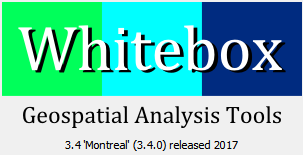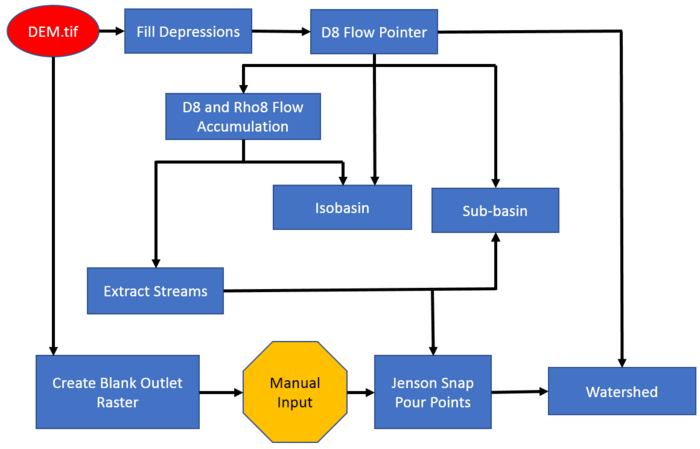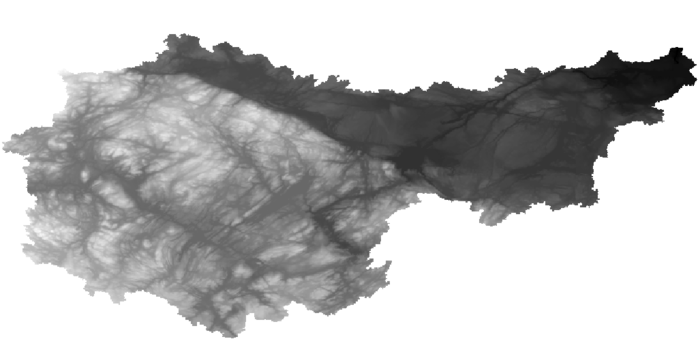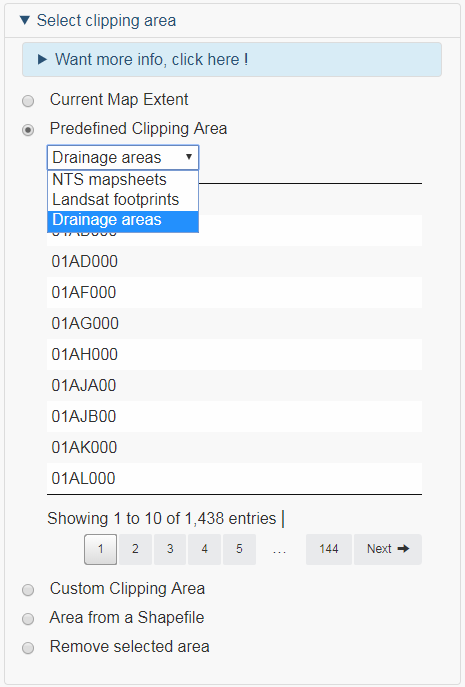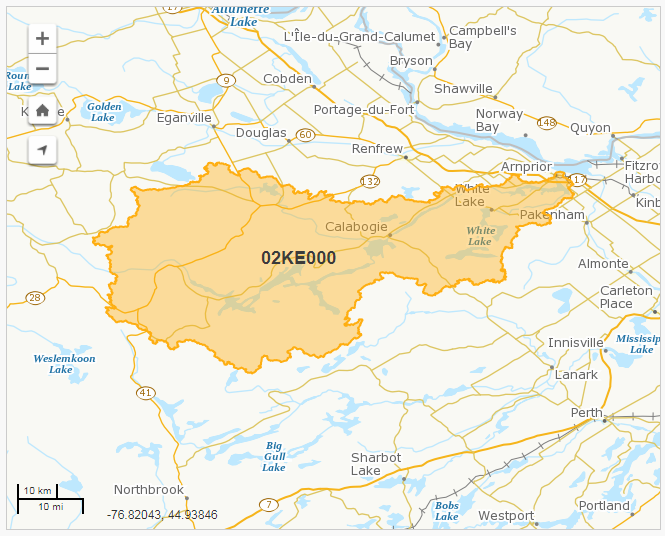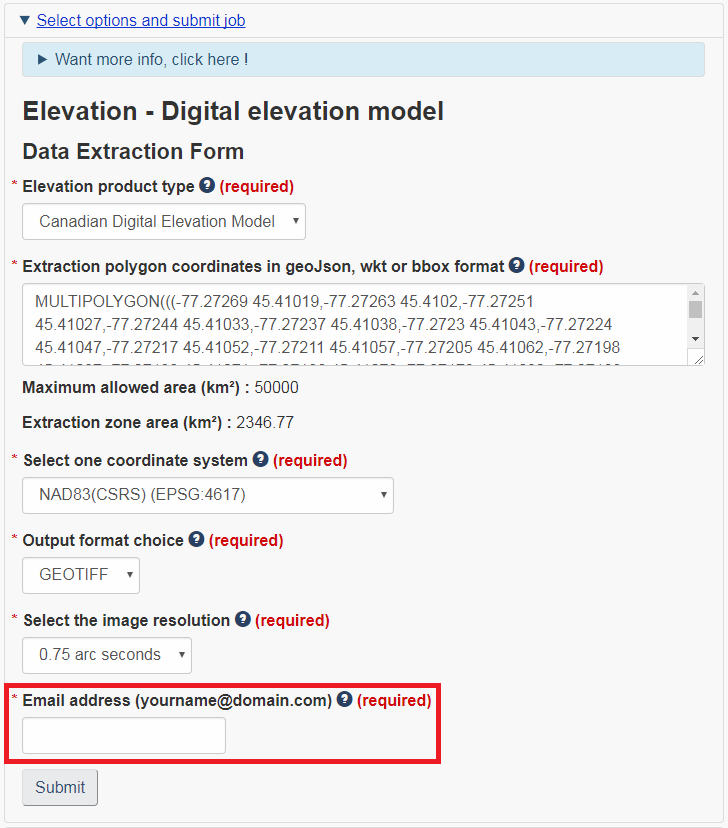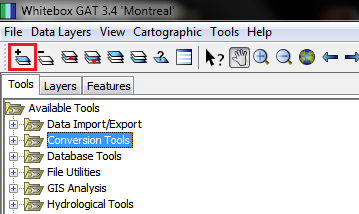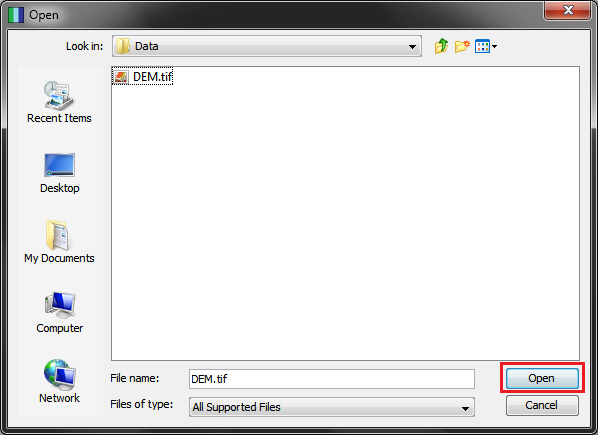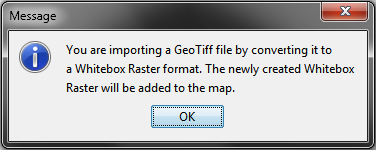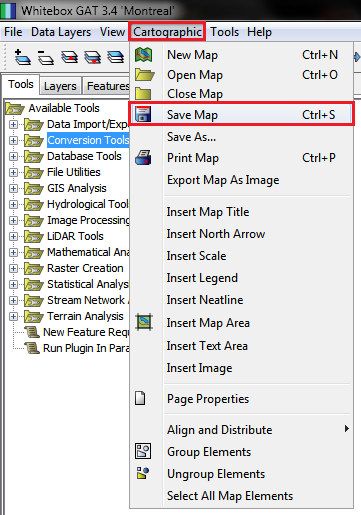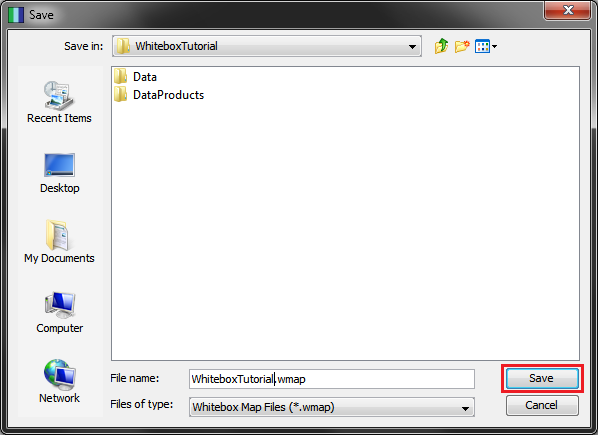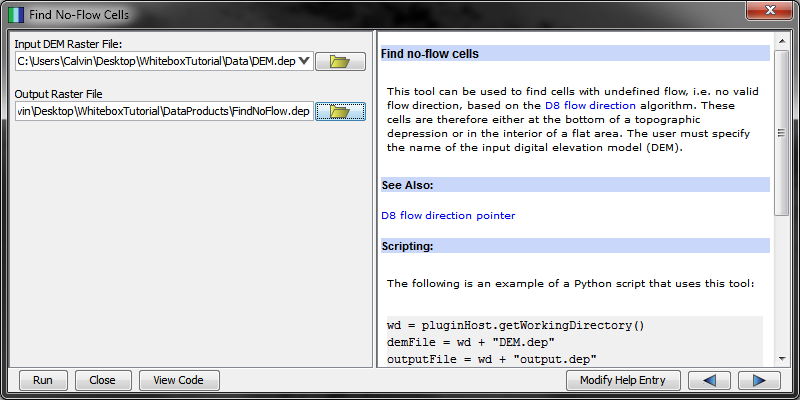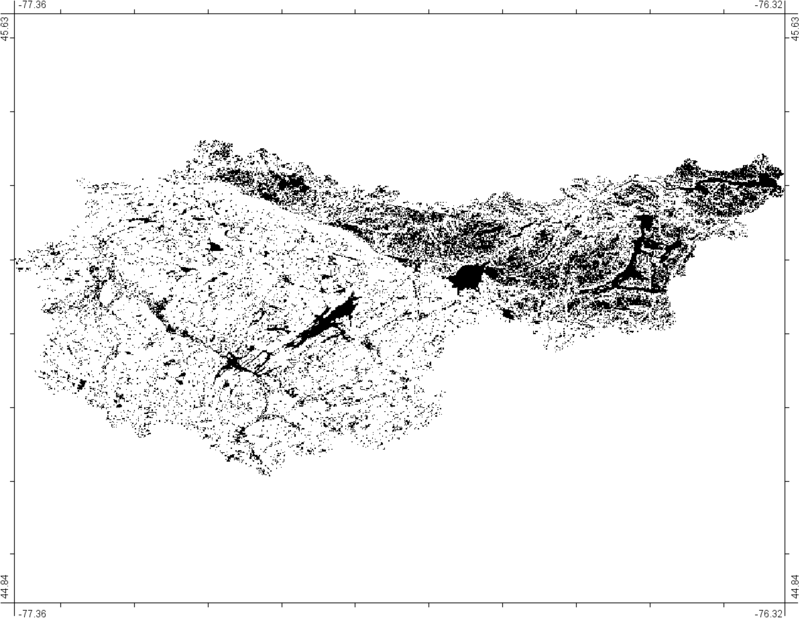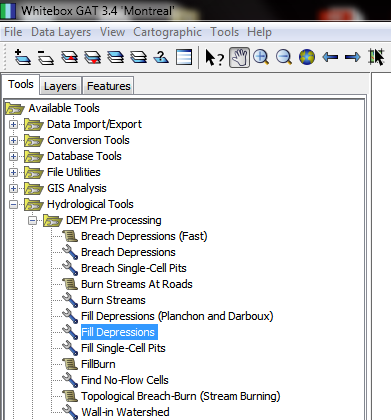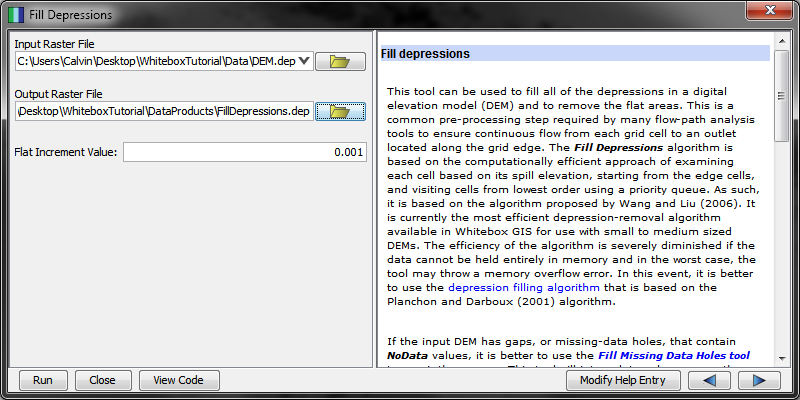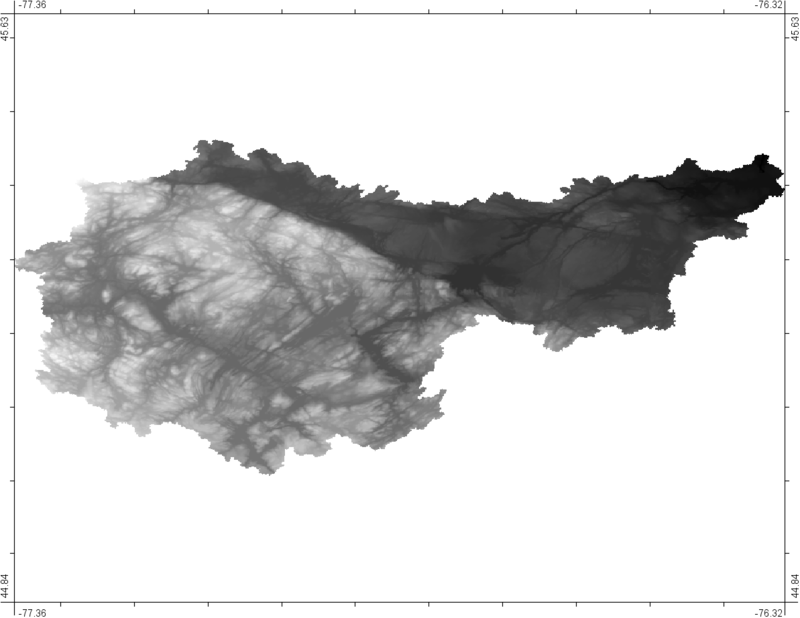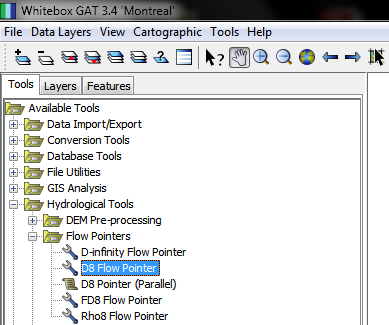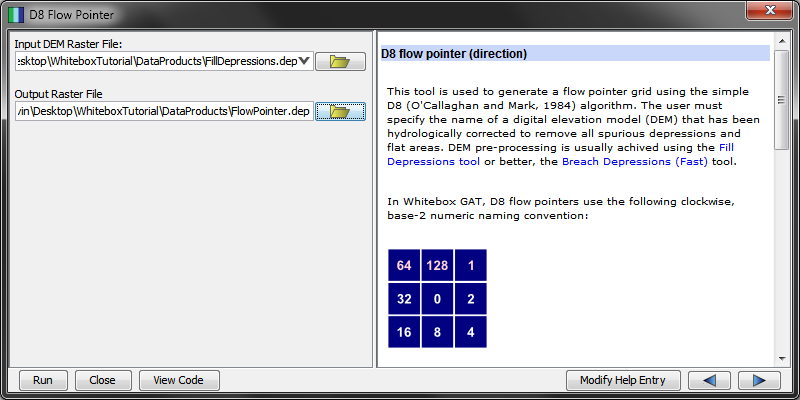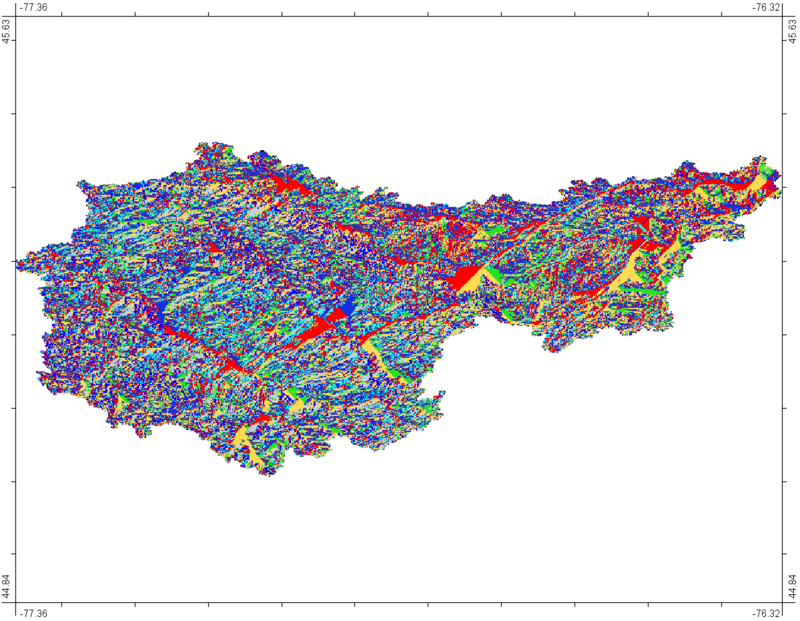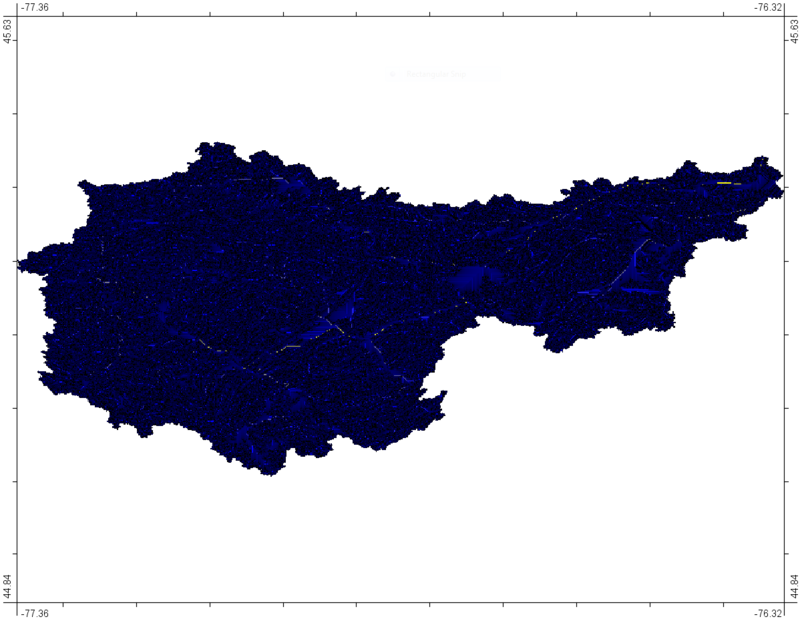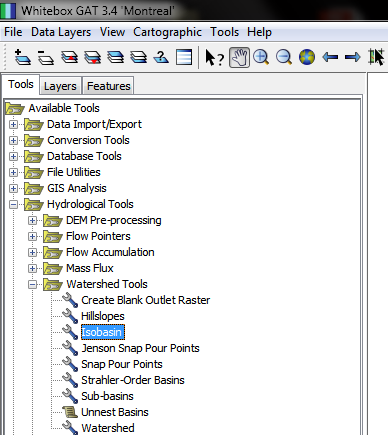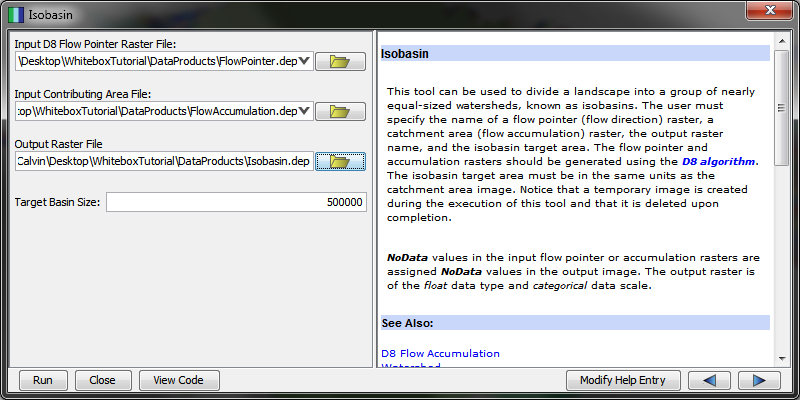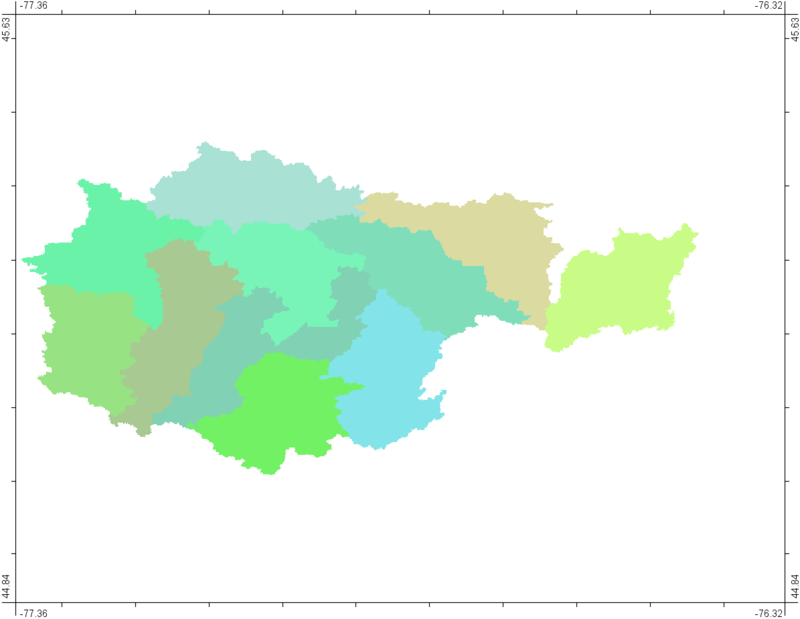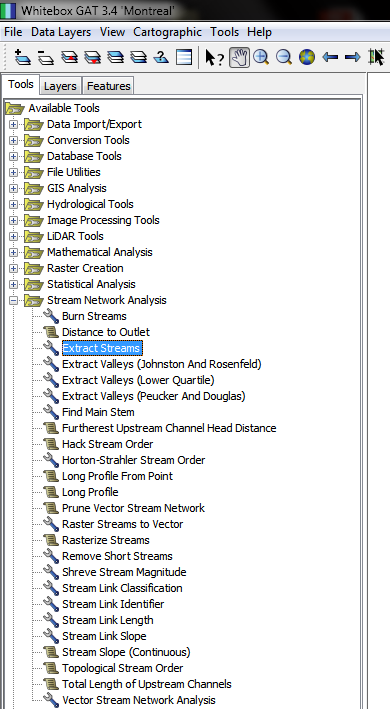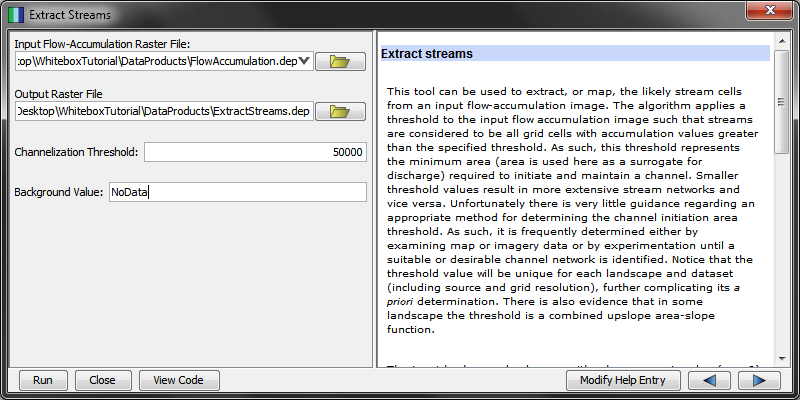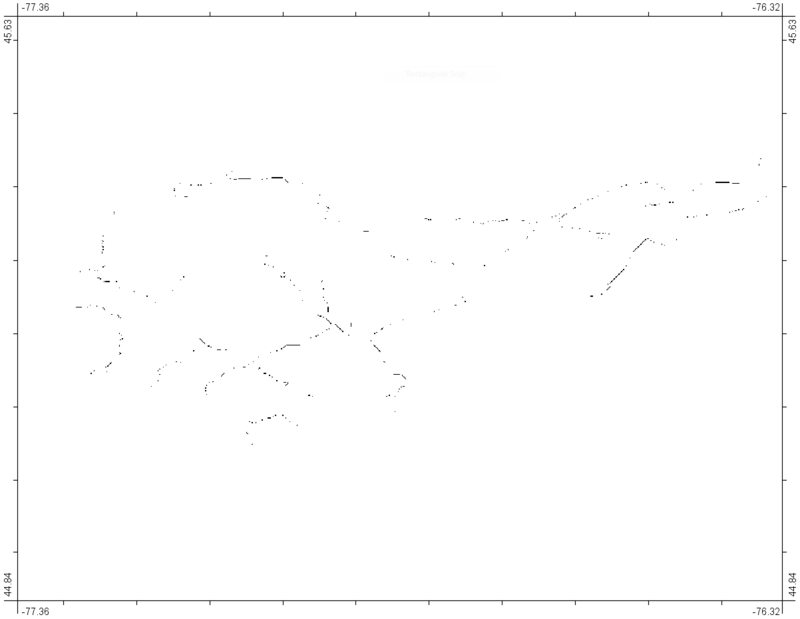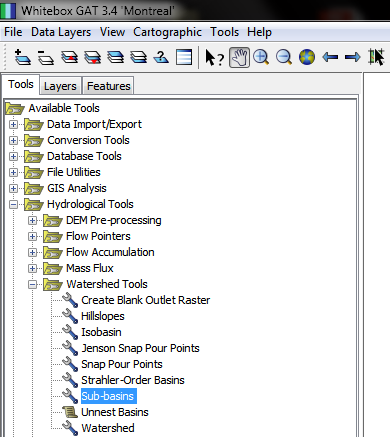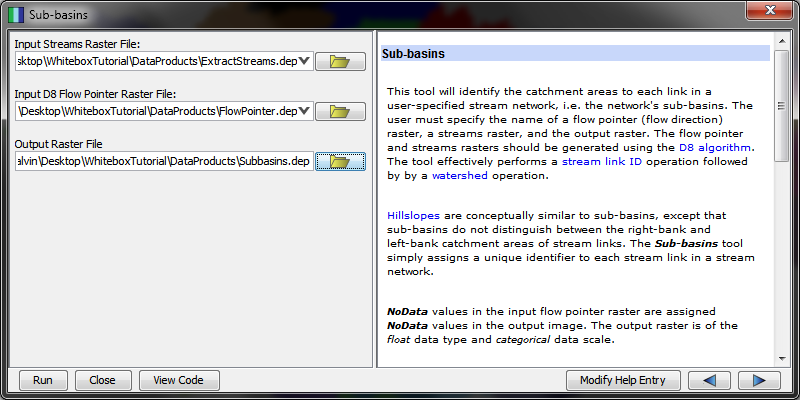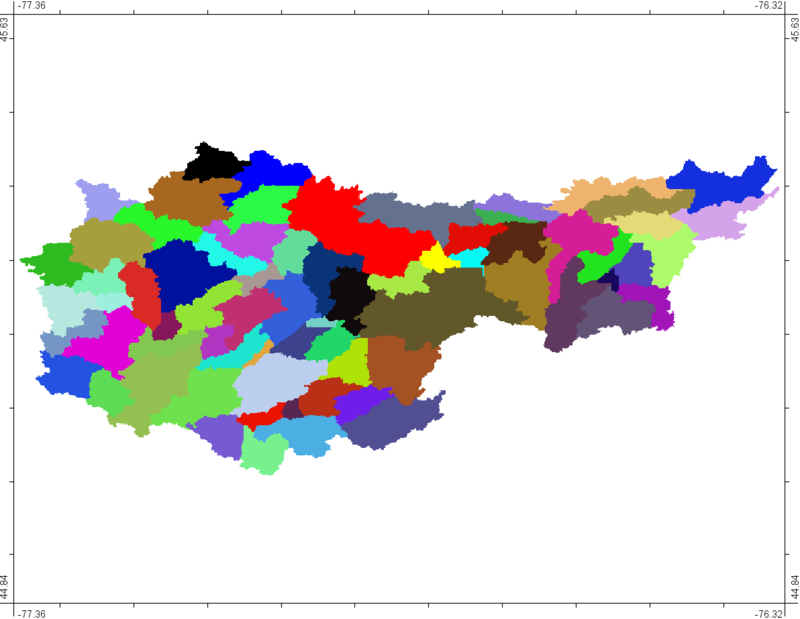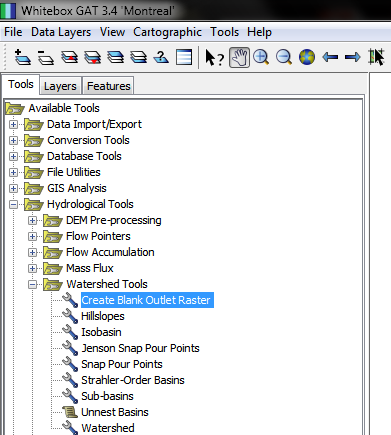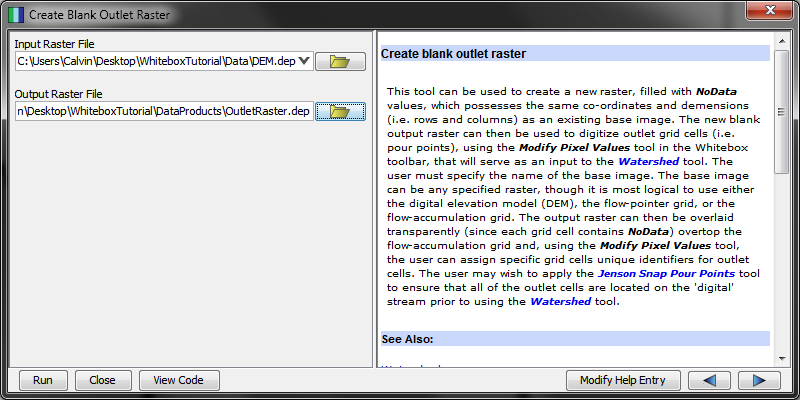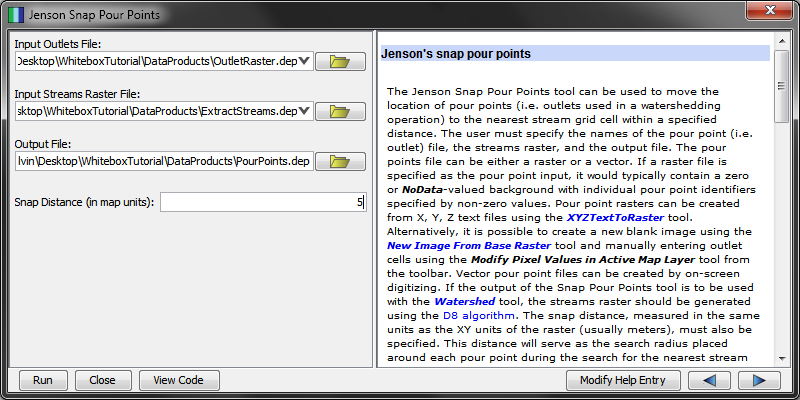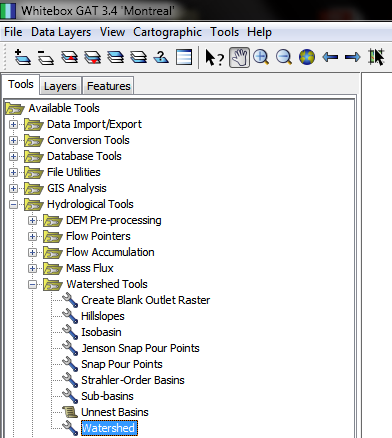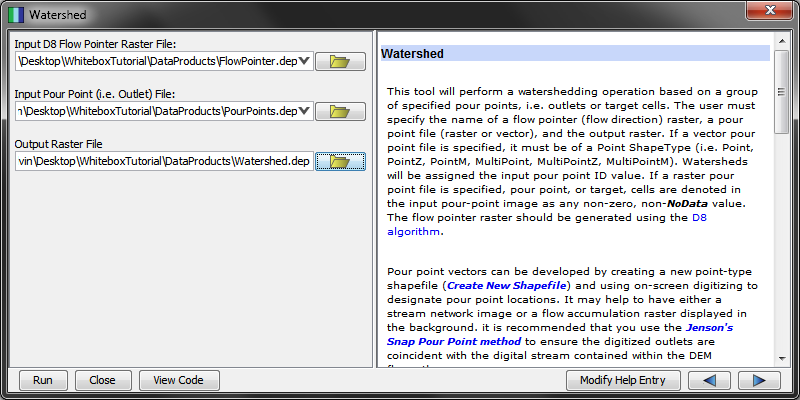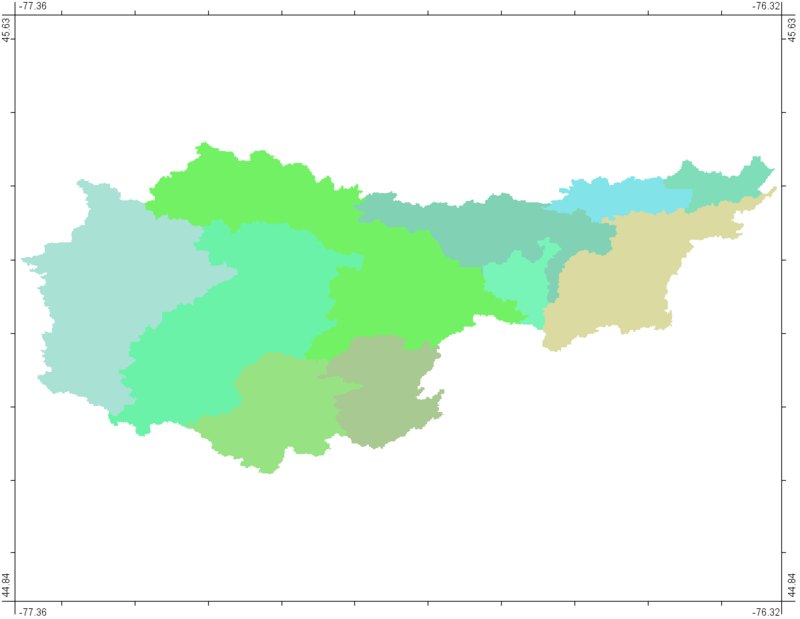Difference between revisions of "Hydrological Analysis Using Whitebox Geospatial Analysis Tools"
Calvin Gale (talk | contribs) (Created page with "==Purpose== The purpose of this tutorial is to guide the [http://www.qgis.org/en/site/ Quantum GIS (QGIS)] user through the steps necessary to create a slope analysis model wo...") |
m (→Watershed) |
||
| (100 intermediate revisions by 2 users not shown) | |||
| Line 1: | Line 1: | ||
==Purpose== |
==Purpose== |
||
| + | The purpose of this tutorial is to guide the user through an exploration of hydrology tools through the process of analyzing the hydrology of an area. |
||
| − | The purpose of this tutorial is to guide the [http://www.qgis.org/en/site/ Quantum GIS (QGIS)] user through the steps necessary to create a slope analysis model workflow using the [http://docs.qgis.org/2.0/en/docs/user_manual/processing/toolbox.html Processing Toolbox]. The user will also learn the basics surrounding the creation of slope, hillshade and aspect maps. The user will also then learn how to export the model as a [http://en.wikipedia.org/wiki/Python_%28programming_language%29 Python] script as well as preform geoprocessing tasks using the QGIS [http://docs.qgis.org/2.0/en/docs/user_manual/working_with_raster/raster_calculator.html Raster Calculator]. This tutorial is designed for a beginner GIS user who has experience with previous GIS software packages however no experience with QGIS. |
||
| + | This tutorial uses the opensource software Whitebox Geospatial Analyst Tools and explores some of the most useful of the hydrology tools included in it. |
||
| + | The intent of this tutorial is for the user to understand the process underwent, an to be able to build off of it for their specific hydrology needs. |
||
| + | |||
| + | This tutorial assumes that the user has some experience with GIS software. |
||
==Introduction== |
==Introduction== |
||
| + | [[File:WhiteboxVersion.png]] |
||
| − | QGIS is a free open source geographical information system application that has geographical viewing, editing and analyzing capabilities. Within QGIS are tools called [https://plugins.qgis.org/ "Plug-ins"]. Plug-ins are essentially developed geoprocessing features made by the QGIS developers as well as independent users who would like to expand and contribute to the functionality of the software. One particular plug-in extension found in QGIS is the Processing toolbox extension. The Processing toolbox extension is similar to the features that are found in ArcMap’s ModelBuilder. Processing is an efficient application that is capable of creating, editing and managing geographical models. The user is able to connect together workflow diagrams that involve a series of geoprocessing algorithms. For the purposes of this tutorial, a workflow will be created using geographical data of [http://en.wikipedia.org/wiki/Carp,_Ontario Carp, Ontario] in order to create a [http://en.wikipedia.org/wiki/Digital_elevation_model digital elevation model (DEM)]. This will then be used to create the slope, hillshade and aspect maps. |
||
| + | This tutorial uses Whitebox 3.4.0, an open source GIS software that was developed within the Center for Hydrogeomatics in Guelph University. As a result this software package has a heavy focus on hydrological analysis. For this reason Whitebox was chosen for this tutorial on hydrological analysis. |
||
| − | This tutorial was also done as a partial requirement of Carleton University's Advanced Topics in Geographic Information Systems 4008 course. |
||
| + | The area of focus in this tutorial is Calabogie Ontario. This location was chosen because the Calabogie peak adds some relief to the area, and the author knew it well enough to tell if there were any errors that occurred during the analysis process. |
||
| + | This tutorial uses a single input, a Digital Elevation model, and produces a multitude of outputs from it, adding information that could be used for future analysis. The process that will be undergone in this tutorial is displayed in the image below. To understand the context of each tool used in this tutorial please refer back to this image as needed. |
||
| − | [[File:QGIS2.18.13.png|center]] |
||
| + | |||
| + | [[File:Overview.PNG|700px]] |
||
| + | |||
| + | ==Data Acquisition== |
||
| + | In this tutorial the only necessary layer is a Digital Elevation Model (DEM) file of your area of interest. In this tutorial we are focusing on Calabogie, ON. It is recommended that you use tthis same dataset for following along. |
||
| + | |||
| + | It can be acquired and downloaded [https://www.dropbox.com/s/gd19qoa0bgqmue3/DEM.tif?dl=0 here]. |
||
| − | ==Data== |
||
| − | In this tutorial the only necessary layer is a Comma Separated Value (CSV) point elevation file of your area of interest. In this tutorial we are focusing on Carp, ON. It is recommended that you use the Carp, Ontario data for following along. It can be acquired and downloaded [https://www.dropbox.com/s/651jlnr63k92qxc/CarpPointData.csv?dl=0 here]. |
||
A sample of this data is shown bellow. |
A sample of this data is shown bellow. |
||
| − | [[File: |
+ | [[File:DataExa.PNG|700px]] |
For the event that the dropbox link has become inactive the process of obtaining this data is described below to make this tutorial relevant for longer. |
For the event that the dropbox link has become inactive the process of obtaining this data is described below to make this tutorial relevant for longer. |
||
| + | |||
Access the Government of Canada Geospatial Data Extraction Application [http://maps.canada.ca/czs/index-en.html here]. |
Access the Government of Canada Geospatial Data Extraction Application [http://maps.canada.ca/czs/index-en.html here]. |
||
| − | In the |
+ | In the “Select Clipping Area” bar enter change the selection to "Predefined Clipping Area" and then select "Drainage areas" from the drop down list that appears. |
| + | |||
| + | [[File:SelectClipArea.png]] |
||
| + | |||
| + | This produces a long list of sequential drainage area names. Search through the names until you find "02KE000" and select it. I found this on the 17th page of drainage area names. |
||
| + | |||
| + | The map extent on the right side of the web page should now match the image below. |
||
| + | |||
| + | [[File:MapExtent.PNG]] |
||
| − | [[File:Extent.png|700px]] |
||
| + | Under “Select Data to be extracted” Select “Elevation – Digital elevation model”. |
||
| − | Select the [[File:Zoom.png]] button to center the map on this location. |
||
| + | Under “Select options and submit job” fill all of the required boxes so that it matches the figure below. Make sure to enter the email address that you would like to have the file sent to in the “Email Address” field. |
||
| − | Next access the bar called “Select clipping area” and select “Current Map Extent”. |
||
| − | Under “Select Data to be extracted” Select “Elevation – Point data”. |
||
| − | Under “Select options and submit job” fill all of the required boxes so that it matches the figure below. Make sure to enter the email address that you would link to have the file sent to in the “Email Address” field. |
||
| − | [[File: |
+ | [[File:SelectOptions.PNG]] |
An email will be sent to the entered email address shortly which contains a URL for the direct download of the data. |
An email will be sent to the entered email address shortly which contains a URL for the direct download of the data. |
||
| − | If neither of these options are available, |
+ | If neither of these options are available, any DEM raster can be used. |
| − | ==Acquiring |
+ | ==Acquiring and Installing Whitebox 3.4.0== |
| − | + | Whitebox version: 3.4.0 (The current version of Whitebox as of 2017 is 3.4.0 and this was the version used for this tutorial. A list of the download links for Windows, Mac and Linux platforms can be found [http://www.uoguelph.ca/~hydrogeo/Whitebox/download.shtml here].) |
|
| + | After the correct .zip file has been downloaded and extracted to your directory of choice the installation process is complete. |
||
| − | ==Getting Started== |
||
| + | It is important that your machine has version 8 or higher of the Java SE Runtime Environment before trying to run Whitebox. This can be acquired [http://www.oracle.com/technetwork/java/javase/downloads/jre8-downloads-2133155.html here]. |
||
| − | ===Launching QGIS 2.18.13=== |
||
| − | When the installation process has finished, an icon should appear on your desktop similar to the one shown below. |
||
| + | ==Getting Started== |
||
| − | [[File:DeskIcon.png]] |
||
| + | ===Launching Whitebox 3.4.0=== |
||
| − | Double-click on that icon and QGIS 2.18.13 will display on your screen. |
||
| + | After the file has been extracted the contents should look similar to the image below. |
||
| + | [[File:FileContents.PNG]] |
||
| − | ===Setting Project Coordinate Reference System (CRS)=== |
||
| − | Following the launch of QGIS 2.18.13, navigate to the top menu bar, select '''Project''', '''Project Properties''', then '''CRS''' on the left column of the popup window. |
||
| + | Double click on the "WhiteboxGIS.jar" file in order to launch the program. |
||
| − | [[File:ProjectionSelection.png]] |
||
| + | '''Note:''' If you are running Windows 10 on your computer you may need to double click on the "Whitebox.bat" file to launch it instead. |
||
| − | Make sure that '''Enable 'on the fly' CRS transformation''' is checked. Once enabled, filter search '''NAD83 (1)''' and select '''NAD83''' under the '''Geographic Coordinate Systems''' '''(2)'''. When finished select '''OK (3)'''. |
||
| + | === Setting up a working Directory === |
||
| − | [[File:ProjectionProperties.png]] |
||
| + | For this Tutorial I created a working directory before starting any analysis processes. This step is not necessary, though it will aid in the organization of this project. |
||
| + | Create a folder called "WhiteboxTutorial", or something similar. |
||
| + | Within this folder create one folder called "Data", and another called "DataProducts". |
||
| + | The final product will look like the image below. |
||
| − | ===Adding Point Data=== |
||
| + | [[File:WorkingDirectory.PNG]] |
||
| − | Adding the Carp elevation data or your desired .csv data requires navigating to the menu bar, select '''Layer''' and '''Add Layer''', '''Add Delimited Text Layer...'''. |
||
| + | Place the DEM.tif data file into the "Data" folder. |
||
| − | [[File:AddCSV.png]] |
||
| + | All files created from the DEM file will be placed in the "DataProducts" folder. i.e. all files output by Whitebox tools while going through this tutorial. |
||
| + | Also, project files will be saved directly within the "WhiteboxTutorial" folder itself. |
||
| + | ===Adding Elevation Data and Saving the Map Project=== |
||
| − | In the popup window browse for the .csv file that holds the elevation point data. Select '''CSV (comma separated values)''' for the file type. The rest of the options should default to the correct settings, but if the popup does not match the figure below make sure that you correct these differences. |
||
| + | To add the elevation data to the project select the icon in the top left of the Whitebox window, highlighted in red in the image below. (or use the hotkey Ctrl + L). |
||
| − | [[File:CSVSettings.png]] |
||
| + | [[File:AddData.png]] |
||
| − | Next you will be asked to choose the projection that the data has. As before filter search '''NAD83 (1)''' and select '''NAD83''' under the '''Geographic Coordinate Systems (2)'''. When finished select '''OK (3)'''. |
||
| + | A popup window will then appear. |
||
| − | [[File:ProjectionProperties.png]] |
||
| + | In this window navigate to the location of the Calabogie DEM data file and select open. |
||
| + | [[File:AddDEM.PNG]] |
||
| − | You should now be able to see your point data in the layers panel but your map view will not be focused on this data. Right click on the point data entry in the layers panel and select '''Zoom to layer'''. |
||
| + | You will likely recive a popup message like the one below. |
||
| − | [[File:ZoomTo.png]] |
||
| + | Select okay to add your data to the map. |
||
| + | [[File:ErrorMsg.PNG]] |
||
| − | ===Converting Point Data to a Shapefile=== |
||
| − | Next we will save this CSV file as a Shapfile to allow for more analysis to be done with it. Right click on the point data entry in the layers panel once again and select '''Save As…''' |
||
| + | To save your project select "Save Map" under the "Cartography" tab. (or use the hotkey Ctrl + S). |
||
| − | [[File:SaveAs.png]] |
||
| + | [[File:SaveMap.png]] |
||
| − | In the popup that appears set the format to '''ESRI Shapefile''', set the file name and directory and ensure that the checkbox beside '''Add saved file to map''' is filled. Select '''OK''' once this is done. |
||
| + | In the pop up window that appears navigate to the location that you would like to save the project and select "Save". |
||
| − | [[File:ToShapefile.png]] |
||
| + | |||
| + | [[File:SaveLoc.PNG]] |
||
You should now be ready for analysis. |
You should now be ready for analysis. |
||
| + | ==Hydrological Analysis== |
||
| − | ==Processing Toolbox== |
||
| − | ===Open Processing Toolbox=== |
||
| + | ===DEM Pre-Processing=== |
||
| − | If the Processing Toolbox is not already displayed on the right side of the QGIS 2.18.13 window, under '''Processing''' in the menu bar, select '''Toolbox'''. |
||
| + | Pre-processing is an important first step in any hydrological analysis as this process identifies and corrects all features within the DEM that may disrupt the flow analysis. Since all products are derived from the DEM it is important to make these corrections at the begging of the process to prevent these errors from carrying through into all of the hydrological outputs. |
||
| − | [[File:Toolbox.png]] |
||
| + | All of the DEM Pre-Processing tools available in Whitebox can be found in the tools menu under the following directory: |
||
| + | Tools> Hydrological Analysis> DEM Pre-Processing |
||
| + | The first tool used in this tutorial is "Find No-Flow Cells", and can be found in the highlighted location in the image below. |
||
| − | This will display the Process Toolbox on the right side of the screen. |
||
| + | This was used to identiy if there were any problem areas, and how extensive they were. |
||
| − | [[File: |
+ | [[File:FindNoFlow.PNG]] |
| + | After double clicking the tool name in the tools list the dialogue box in the image bellow will appear. |
||
| − | ===Creating a model using Graphical modeler=== |
||
| + | Set the Calabogie area DEM as the "Input DEM Raster File". |
||
| + | Make sure that the "Output Raster File" will be saved within the DataProducts folder in the directory you set up and give it a name similar to "FindNoFlow.dep". |
||
| + | After these inputs have been set click "Run" in the bottom left of the popup window. |
||
| + | [[File:FindNoFlowMsg.PNG]] |
||
| − | To create a model workflow navigate to the menu bar, under '''Processing''', select '''Graphical modeler'''. |
||
| + | After the tool runs it will produce a file that looks like the one below. The black areas in this image are all of the problem areas identified that could cause problems for flow analysis. These areas tend to correspond with errors in the DEM if they are small, or basins in the landscape if they are large. The high amount of no flow areas identified using this tool means that a pre-processing correction tool will be necessary. |
||
| − | [[File:Image008.png]] |
||
| + | [[File:FindNoFlowOtp.PNG|800px]] |
||
| − | Once the modeler window has opened, you can begin to create the desired workflow. For this particular tutorial, the Carp elevation shapefile will be used to create a slope analysis workflow. |
||
| + | In this tutorial the "Fill Depressions" tool is used to correct the no flow areas. This was chosen because it is much more computationaly efficient than any of the breach tools, finishing much quicker. |
||
| − | Before creating the model, you must enter a desired model name and group name '''(1)'''. I named my model '''Slope Analysis Turotial''' under a group name called '''GEOM 4008'''. Once a model and group name have been entered, select '''Save (2)''', and save the model to your desired folder. I would recommend creating a folder just for QGIS models under this project. |
||
| + | This tool is found in the location below. |
||
| − | To begin your model, you'll first have to add an input parameter. On the left side of the modeler window, select '''Vector Layer (3)'''. That will then display a '''Parameter definition (4)''' window. Enter the '''Parameter name''' as '''Input elevation points''' (or something similar), '''Shapefile''' to '''Point''', and '''Required''' to '''Yes'''. Select '''Ok'''. |
||
| + | [[File:Fill.PNG]] |
||
| − | Now navigate to the '''Algorithm (5)''' tab, to being adding geoprocessing algorithms. |
||
| + | The dialog box that appears for this tool is shown below. The input file should be set to the original Calabogie DEM, and the output should be set to the DataProducts folder and named something similar to "FillDepressions.dep". |
||
| − | [[File:InputParameter.png]] |
||
| + | The "flat increment value" is the step value added to cells within a flat area in order to ensure that they have a slight slope instead of remaining flat. This was kept at the default value of "0.001". After these inputs have been set click "Run" in the bottom left of the popup window. |
||
| + | [[File:FillDepressions.PNG]] |
||
| − | ===Adding Geoprocessing Algorithms=== |
||
| + | The output of this tool is shown below. It does not appear very different to the original DEM, but will closer inspection differences within the areas identified in the Find No-Flow Cells output can be seen. |
||
| − | ====3D transformation==== |
||
| + | [[File:FillDepressionsOtp.PNG|800px]] |
||
| − | The first algorithm that will be added will transform our 2-dimensional point data into a 3-dimensional dataset. This is required because by default point data in QGIS is interpreted as 2-dimensional meaning that only the X and Y values from the attribute table are considered for analysis, not the Z which is the elevation data. The algorithm used can be found by doing a search filter for '''3D (1)''', and select '''v.to.3d (2)''' under '''GRASS Commands'''. |
||
| − | A window will open asking for the specifications '''(3)'''. Enter the specifications that you desire. |
||
| − | Make sure that the '''Input layer''' is the elevation point data initially added, and that the Name of attribute column used for height is '''Z'''. Also add an '''Output Vector''' name of your choice. Select '''OK'''. |
||
| + | ===Flow Pointer=== |
||
| − | [[File:3D.png]] |
||
| + | A flow pointer tool in Whitebox is a tool that identifies which area surrounding a cell is the lowest. The value of this cell is then assigned corresponding to the relative direction of this area. This information is not too useful on its own, but it is used as an input to many other hydrology tools because it denotes the direction that water will flow from each cell. |
||
| − | ====Inverse Distance Weighted (IDW)==== |
||
| + | Whitebox has many different flow pointer tools that each use a different method to produce their results. |
||
| − | The second algorithm that will be added is an '''Inverse Distance Weighted (IDW)''' [http://en.wikipedia.org/wiki/Interpolation interpolation]. This particular algorithm can be found by doing a search filter for '''IDW (1)''', and select '''v.surf.idw (2)''' under '''GRASS Commands'''. |
||
| + | In this tutorial "D8 Flow Pointer" was used because many of the tools in the "Watershed Tools" toolset will only work with the output from the D8 Flow Pointer as an input. |
||
| + | This tool is found in the location shown below. |
||
| + | [[File:FlowPointer.PNG]] |
||
| − | A window will open asking for interpolation specifications '''(3)'''. Enter the specifications that you desire. |
||
| + | The dialog box for this too is shown below. The input DEM raster file should be set to the output from the Fill Depressions tool (FillDepressions.dep), and the output should be set to the DataProducts folder and named something similar to "FlowPointer.dep". After these inputs have been set click "Run" in the bottom left of the popup window. |
||
| − | Make sure that the '''Input layer''' is the output from the '''2D to 3D transformation'''. |
||
| + | [[File:FlowPointerMsg.PNG|800px]] |
||
| − | For my slope analysis, I had to enter '''Z''' into the '''Attribute table column with values to interpolate''' field because the column under the '''PointDataShapefile''' Attribute Table used for elevation points is named '''Z'''. |
||
| + | The output from this tool is displayed below. This image contained 8 colours corresponding to the 8 directions of flow. This image appears chaotic, but will be used in other tools to create more informative data products. |
||
| − | I also used a '''GRASS region cellsize''' of '''0.0005'''. This can be changed if you'd like, although it may take longer to process with a smaller cell size value. Also add an '''Output raster''' name of your choice. Select '''OK'''. |
||
| − | [[File: |
+ | [[File:FlowPointerOtp.PNG|800px]] |
| − | === |
+ | ===Flow Accumulation=== |
| + | Flow Accumulation tools analyze the magnitude of cells that pour into or through an area. |
||
| − | Following the IDW interpolation, a slope map expressed in degrees will be created using the IDW output. |
||
| + | This is useful on its own, allowing us to determine the relative flow through areas by comparing values of the output, and is also used as an input for many other analyses. |
||
| + | In this tutorial the "D8 and Rho8 Flow Accumulation" tool was used, as this was the one that corresponded to the D8 Flow Pointer output that was created with the previous tool. |
||
| − | Execute a search filter for '''Slope (1)''', and select '''Slope (2)''' under '''GDAL/OGR'''. |
||
| + | This tool is located in the location displayed below. |
||
| + | [[File:FlowAccumulation.PNG]] |
||
| − | This will display a window for the Slope geoalgorithm '''(3)'''. Leave the field parameters as default except for '''Slope expressed as percent''' to '''No'''. Make sure that the '''Input layer''' is the '''Interpolated IDW output'''. |
||
| + | The dialog box for this tool is displayed below. The input D8 flow pointer raster file should be set to the output from the D8 flow pointer tool (FlowPointer.dep), and the output should be set to the DataProducts folder and named something similar to "FlowAccumulation.dep". In the example the "Output Type" was set to "number of upslope grid cells" so that a greater cell value in the output would correspond to a greater number of cells flowing through that cell. The "Log-transformed flow accumulation values?" box was left unchecked in this example, though checking this would help normalize the data for better display. After these inputs have been set click "Run" in the bottom left of the popup window. |
||
| − | Also add an '''Output raster''' name of your choice. Select '''OK'''. |
||
| − | [[File: |
+ | [[File:FlowAccumulationMsg.PNG|800px]] |
| + | The output of this tool is displayed below. The brighter areas correspond to areas of higher accumulated flow. These areas of high flow correspond to the areas where more water gathers and flows together. A beter picture of the data can be gathered by zooming into the output in Whitebox. |
||
| − | ====Aspect==== |
||
| + | [[File:FlowAccumulationOtp.PNG|800px]] |
||
| − | Execute a search filter for '''Aspect (1)''', and select '''Aspect (2)''' under '''GDAL/OGR'''. |
||
| + | ===Isobasin=== |
||
| − | This will display a window for the Aspect geoalgorithm '''(3)'''. Leave the specifications as default. Make sure that the '''Input layer''' is the '''Interpolated IDW output'''. |
||
| + | The isobasin tool divides a study area into equally sized drainage areas (iso-basins) of a specified size. |
||
| − | Also add an '''Output raster''' name of your choice. Select '''OK'''. |
||
| + | The location of this tool is displayed below. |
||
| − | [[File:AspectAlg.png]] |
||
| + | [[File:Isobasin.PNG]] |
||
| − | ====Hillshade==== |
||
| + | The dialog box for this tool is displayed below. The input D8 flow pointer raster file should be set to the output from the D8 flow pointer tool (FlowPointer.dep), and the input contributing area file sould be set to the output from the D8 and Rho8 Flow Accumulation tool (FlowAccumulation.dep). The output should be set to the DataProducts folder and named something similar to "Isobasin.dep". |
||
| − | Execute a search filter for '''Hillshade (1)''', and select '''Hillshade (2)''' under '''GDAL/OGR'''. |
||
| + | For this example the "Target Basin Size" was set to 500,000 cells. This value was found using trial an error to find an output that looked appropriate. After these inputs have been set click "Run" in the bottom left of the popup window. |
||
| + | [[File:IsobasinMsg.PNG|800px]] |
||
| − | This will display a window for the Hillshade geoalgorithm '''(3)'''. Leave the specifications as default. Make sure that the '''Input layer''' is the '''Interpolated IDW output'''. |
||
| + | The output from this look is displayed below. It can be seen that the area has been broken down into 11 different basins of approximately equal size. It also appears that the basins do not fill the entire study area. This is likely because no more basins of a size of 500,000 cells could be fit into these areas. If the target basin size was set to a lower number these basins would conform to the study area more completely. |
||
| − | Also add an '''Output raster''' name of your choice. Select '''OK'''. |
||
| − | [[File: |
+ | [[File:IsobasinOtp.PNG|800px]] |
| − | === |
+ | ===Extract Streams=== |
| + | Stream networks can be useful as an input for other tools. Also, on their own they allow knowledge of areas of high water and nutrient flow, as well as connecting areas between water habitats. |
||
| − | Once all of the geoprocessing algorithms have been added, the model should look similar to the capture below. |
||
| + | The "Extract Streams" tool was used for this purpose. This tool extracts all values from a flow accumulation output that are greater than the specified value. This tool is not located within the Hydrology Tools toolset, and is part of the "Stream Network Analysis" toolset instead. |
||
| − | Make sure that you '''Save (1)''' the model before '''Running the model (2)'''. |
||
| + | The location of this tool is displayed below. |
||
| − | [[File: |
+ | [[File:ExtractStreams.PNG]] |
| + | The dialog box for this tool is displayed below. The input flow-accumulation raster file should be set to the output from the D8 and Rho8 Flow Accumulation (D8 and Rho8 Flow Accumulation), and the output should be set to the DataProducts folder and named something similar to "ExtractStreams.dep". The "Channelization Threshold" is the cutoff value that will be used to determine which cells are a stream and which cells aren't. Trial and error was used to determine a value that produced an appropriate stream network. A value of 50,000 was settled on. The "Background Value" was set to "NoData" so that all of the cells that were not streams would be transparent. After these inputs have been set click "Run" in the bottom left of the popup window. |
||
| − | When the '''Run model''' button is select, a window the same as the capture below will appear. |
||
| + | [[File:ExtractStreamsMsg.PNG|800px]] |
||
| − | In this window make sure you save the output files to an appropriate destination folder. Select '''OK''' to run the model. |
||
| + | The output of the tool is displayed below. This output looks patchy at the full extent, but by zooming into it within Whitebox you can confirm that a network of continuous lines has been produced. |
||
| − | Also check to make sure that '''PointDataShapefile''' is the '''Input elevation points''' that will be Transformed first in the model. |
||
| − | [[File: |
+ | [[File:ExtractStreamsOtp.PNG|800px]] |
| + | ===Sub-basins=== |
||
| − | Once the model is finished running, the output layers will be displayed in the '''Layer''' toolbox on the left side. |
||
| + | The sub-basin tool breaks the down the study area into a number of basins, with one basin for each segment of a stream network for the area. As a result each of these basins represent the catchment area for each segment of the river network. |
||
| − | [[File:LayerOutput.png]] |
||
| + | The location of this tool is displayed below. |
||
| − | ===Displaying output rasters from model=== |
||
| + | [[File:Subbasins.PNG]] |
||
| − | Once the model is run and the output rasters appear in the '''Layer''' toolbox. They will only appear as single band image styles. |
||
| + | The dialog box for this tool is displayed below. The input streams raster file should be set to the output from the extract streams tool (ExtractStreams.dep), and the input D8 flow pointer raster should be set to the output from the D8 flow pointer tool (FlowPointer.dep). The output should be set to the DataProducts folder and named something similar to "Subbasins.dep". After these inputs have been set click "Run" in the bottom left of the popup window. |
||
| − | One way to change this is to change this '''right click''' on '''Output IDW''', select '''Properties'''. |
||
| − | [[File: |
+ | [[File:SubbasinsMsg.PNG|800px]] |
| + | The output from this tool is displayed below. This image shows a much greater number of basins than any of the outputs from other tools in this tutorial, likely due to the complexity of the stream network fed into the tool. It would be expected that if the channelization threshold used for the extract streams tool was higher, there would be less sub-basins, and if it was lower there would be more. |
||
| − | A '''Layer Properties''' window will appear. Navigate to '''Style (1)''', select the '''Render type''' to '''Singleband pseudocolour (2)'''. The rest of the properties can be changed to your personal desire. For my output I selected '''Spectral (3)''' for the color and '''Quantile''' mode '''(4)''' and then selected '''OK (4)'''. |
||
| − | [[File: |
+ | [[File:SubbasinsOtp.PNG|800px]] |
| + | ===Watershed Analysis=== |
||
| − | This process can be done for any of the output raster layers. The IDW output was done as an example. The output should look similar to the capture below, depending on the cell size used in the modeling process. |
||
| + | In order to run the Watershed tool this first step will be to create pour points. Once this is done The watershed analysis can be done. |
||
| + | ====Pour Points==== |
||
| + | Pour points are used in watershed analysis to define each of the watersheds that will be output. Simply put, a watershed is the entire area that flows into a pour point. As a result the placement of these pour points greatly effects the output of the watershed analysis. Pour points are usually located in areas of high accumulated flow, so are usually located on points of a stream network. |
||
| + | There is no way to create a pour point file in Whitebox automaticaly, so this must be done manualy. |
||
| − | [[File:IWDOutput.png]] |
||
| + | The first step in making a pour point file is to make a blank file. This is achieved using the "Create Blank Outlet Raster" tool, which creates a file that is identical to the input file, except that every cell contains "NoData" values. |
||
| + | The location of this tool is displayed in the following image. |
||
| − | It is also possible to change the transparencies of the layers and overlay them on top of one another for more visually pleasing final maps. The following map was created by setting the transparency of the IDW layer to 10% and overlaying it onto of the Hillshade layer. |
||
| − | [[File: |
+ | [[File:BlankOutletRaster.PNG]] |
| + | The dialog box of this tool is displayed below. The input raster file should be set to the original Calabogie DEM file and the output should be set to the DataProducts folder and named something similar to "OutletRaster.dep". After these inputs have been set click "Run" in the bottom left of the popup window. |
||
| − | ===Exporting your model=== |
||
| + | [[File:BlankOutletRasterMsg.PNG|800px]] |
||
| − | Once you finish your model it can be exported for further use. |
||
| + | The output of this tool will be a blank raster file. |
||
| − | [[File:ModelOutput.png]] |
||
| + | Pour points must now be identified and added. Before this can be done, the layers in the data tab have to be set up. I made sure that only the extract streams output and the create blank outlet raster output were visible, and that only the create blank outlet raster output was highlighted in the layer list. |
||
| − | ====As an Image==== |
||
| + | Next the Modify Pixel Values tool must be used. The location of this tool is displayed below. |
||
| − | If you'd like to print out the finished model or include it in a report it is possible to save the model as an image for future reference a picture of the model can be saved using the indicated button '''(1)'''. |
||
| + | [[File:ModifyPixelTool.png]] |
||
| − | ====As a Python script==== |
||
| + | After clicking this button your cursor will become a cross-hair when mousing over your data frame. The center of this cross-hair is the location of the pixel that will be altered using this tool. |
||
| − | It is also possible to export the model as Python script using the second indicated button '''(2)'''. |
||
| − | This Python script can be edited in a program such as Notepad++. |
||
| + | Click on a location along the stream network, such as the location displayed below. |
||
| − | [[File:PythonModel.png]] |
||
| + | [[File:ModifyPixelToolUse.png|800px]] |
||
| − | ==Raster Calculations== |
||
| + | When you click a small window like the one below will appear. This window tells you the co-ordinates of the pixel you are changing, and the current value of the pixel. The value should currently be NoData. |
||
| − | In addition to creating a model using the Processing toolbox, the '''QGIS raster calculator''' can be used to input certain expressions to preform multiple geoprocessing tasks. For the purposes of this tutorial I will be extracting all areas from the slope map that are not flat, (i.e. '''don't have a slope of 0 degrees'''). |
||
| − | First navigate to the menu bar, under '''Raster''', select '''Raster Calculator...'''. |
||
| + | Change this value from NoData to 1. |
||
| − | [[File:CalcSelection.png]] |
||
| + | [[File:ModifyPixelToolMsg.png]] |
||
| − | A '''Raster calculator''' window will open. Inside the expression field insert the following expression '''(1)''': '''( "Output Slope@1" > 0 ) OR ( "Output Slope@1" < 0 )'''. I would recommend manually clicking the operators to avoid typing error. When done entering the expression, at the bottom of the window it should say "expression valid". |
||
| + | Repeat this process until you are happy with the placement of your pour points, making sure that the value of each pour point is unique. |
||
| − | Remember to save the output as something that is easily recognizable '''(2)''', example, SlopeCalc.tif. Select '''OK (3)'''. |
||
| + | For the example in this tutorial 10 pour points were spread evenly along the stream network and were given sequential values from 1 to 10. |
||
| − | [[File:RasterCalculator.png]] |
||
| + | It is important that the placement of these pour points is on the stream network, so the Jenson Snap Pour Points tool will now be used to make sure that this is true. |
||
| − | When finished you should have an output map like the one indicated below. All areas without a slope of 0 degrees are represented in black and all other areas are in white. |
||
| + | The location of this tool is displayed below. |
||
| − | [[File:SlopeCalc.png|box]] |
||
| + | [[File:SnapPourPoints.PNG]] |
||
| − | The following process can be done for any of the output terrain maps. Extracting areas without a slope of 0 degrees was done as an example. |
||
| + | The dialog box for this tool is displayed below. The input outlets file should be set to the output from the create blank outlet raster tool that you have just modified (OutletRaster.dep). The input streams raster should be set to the output from the extract streams tool (ExtractStreams.dep). The output should be set to the DataProducts folder and named something similar to "PourPoints.dep". After these inputs have been set click "Run" in the bottom left of the popup window. |
||
| − | ==Conclusion== |
||
| − | In conclusion, this tutorial was aimed to give the user the skills to create workflows using the QGIS Processing Toolbox while also creating a workshop for slope and terrain analysis. This tutorial also gives the user the very basic introduction into the GIS world of Python scripting as well. The Python scripts that were exported can be slightly edited to preform the same geoprocessing tasks but with different parameters if necessary. |
||
| + | [[File:SnapPourPointsMsg.PNG|800px]] |
||
| − | ==Resource Links== |
||
| − | [http://docs.qgis.org/2.18/en/docs/index.html QGIS version 2.18 Documentation] |
||
| + | ====Watershed==== |
||
| − | [http://www.gdal.org/ GDAL - Geospatial Data Abstraction Library] |
||
| + | Now that the pour point raster has been created and snapped to the stream network the watershed analysis can be undergone. The location of this tool is displayed below. |
||
| − | [http://support.esri.com/en/knowledgebase/GISDictionary/term/aspect Aspect - GIS Dictionary] |
||
| + | [[File:Watershed.PNG]] |
||
| − | [http://support.esri.com/en/knowledgebase/GISDictionary/term/hillshading Hillshade - GIS Dictionary] |
||
| + | The dialog box for this tool is displayed below. The D8 flow pointer raster file should be set to the output from the D8 flow pointer tool (FlowPointer.dep). The pour point file should be set to the output from the Jenson snap pour points tool (PourPoints.dep). The output should be set to the DataProducts folder and named something similar to "Watershed.dep". After these inputs have been set click "Run" in the bottom left of the popup window. |
||
| − | [http://support.esri.com/en/knowledgebase/GISDictionary/term/interpolation Interpolation - GIS Dictionary] |
||
| + | [[File:WatershedMsg.PNG|800px]] |
||
| − | [http://support.esri.com/en/knowledgebase/GISDictionary/term/slope Slope - GIS Dictionary] |
||
| + | The output of this tool is displayed below. This shows 10 watershed ares, corresponding to the locations that the pour points were located. Each of these watersheds also conserve the value that its pour point had, meaning that any hierarchy or numbering system will be kept. |
||
| − | [http://learnpythonthehardway.org/ Python - Learn Python the Hard Way] |
||
| + | The number and location of your watershed areas will differ as a result of the different pour points used. |
||
| − | [http://notepad-plus-plus.org/ Notepad++ Homepage] |
||
| + | [[File:WatershedOtp.PNG|800px]] |
||
| − | ==References== |
||
| + | |||
| − | Crosetto, M., Tarantola, S., & Saltelli, A. (2000). Sensitivity and uncertainty analysis in spatial modelling based on GIS. ''Agriculture, Ecosystems and Environment'', 81(1), 71-79. doi:10.1016/S0167-8809(00)00169-9 |
||
| + | ==Conclusion== |
||
| + | This tutorial aimed to give the user in introduction to hydrological analysis using Whitebox GAT 3.4.0. This was done by taking the user through an organized process that linked many of the hydrology tools together and explained why they were used and how the parameters were decided for each one. |
||
| − | Hutchinson, M.F., 1998. Interpolation of Rainfall Data with Thin Plate Smoothing Splines – Part II: Analysis of Topographic Dependence. ''Journal of Geographic Information and Decision Analysis'', vol.2, no. 2, pp. 152-167, 1998. |
||
| + | The user should now have a good basis of knowledge that will help them with future hydrological analysis in Whitebox Geospatial Analysis Tools. |
||
| − | R.E. Crochiere and L.R. Rabiner. (1983). Multirate Digital Signal Processing. Englewood Cliffs, NJ: Prentice–Hall. |
||
Latest revision as of 16:06, 3 January 2018
Contents
Purpose
The purpose of this tutorial is to guide the user through an exploration of hydrology tools through the process of analyzing the hydrology of an area. This tutorial uses the opensource software Whitebox Geospatial Analyst Tools and explores some of the most useful of the hydrology tools included in it. The intent of this tutorial is for the user to understand the process underwent, an to be able to build off of it for their specific hydrology needs.
This tutorial assumes that the user has some experience with GIS software.
Introduction
This tutorial uses Whitebox 3.4.0, an open source GIS software that was developed within the Center for Hydrogeomatics in Guelph University. As a result this software package has a heavy focus on hydrological analysis. For this reason Whitebox was chosen for this tutorial on hydrological analysis. The area of focus in this tutorial is Calabogie Ontario. This location was chosen because the Calabogie peak adds some relief to the area, and the author knew it well enough to tell if there were any errors that occurred during the analysis process.
This tutorial uses a single input, a Digital Elevation model, and produces a multitude of outputs from it, adding information that could be used for future analysis. The process that will be undergone in this tutorial is displayed in the image below. To understand the context of each tool used in this tutorial please refer back to this image as needed.
Data Acquisition
In this tutorial the only necessary layer is a Digital Elevation Model (DEM) file of your area of interest. In this tutorial we are focusing on Calabogie, ON. It is recommended that you use tthis same dataset for following along.
It can be acquired and downloaded here.
A sample of this data is shown bellow.
For the event that the dropbox link has become inactive the process of obtaining this data is described below to make this tutorial relevant for longer.
Access the Government of Canada Geospatial Data Extraction Application here.
In the “Select Clipping Area” bar enter change the selection to "Predefined Clipping Area" and then select "Drainage areas" from the drop down list that appears.
This produces a long list of sequential drainage area names. Search through the names until you find "02KE000" and select it. I found this on the 17th page of drainage area names.
The map extent on the right side of the web page should now match the image below.
Under “Select Data to be extracted” Select “Elevation – Digital elevation model”.
Under “Select options and submit job” fill all of the required boxes so that it matches the figure below. Make sure to enter the email address that you would like to have the file sent to in the “Email Address” field.
An email will be sent to the entered email address shortly which contains a URL for the direct download of the data.
If neither of these options are available, any DEM raster can be used.
Acquiring and Installing Whitebox 3.4.0
Whitebox version: 3.4.0 (The current version of Whitebox as of 2017 is 3.4.0 and this was the version used for this tutorial. A list of the download links for Windows, Mac and Linux platforms can be found here.)
After the correct .zip file has been downloaded and extracted to your directory of choice the installation process is complete.
It is important that your machine has version 8 or higher of the Java SE Runtime Environment before trying to run Whitebox. This can be acquired here.
Getting Started
Launching Whitebox 3.4.0
After the file has been extracted the contents should look similar to the image below.
Double click on the "WhiteboxGIS.jar" file in order to launch the program.
Note: If you are running Windows 10 on your computer you may need to double click on the "Whitebox.bat" file to launch it instead.
Setting up a working Directory
For this Tutorial I created a working directory before starting any analysis processes. This step is not necessary, though it will aid in the organization of this project. Create a folder called "WhiteboxTutorial", or something similar. Within this folder create one folder called "Data", and another called "DataProducts".
The final product will look like the image below.
Place the DEM.tif data file into the "Data" folder. All files created from the DEM file will be placed in the "DataProducts" folder. i.e. all files output by Whitebox tools while going through this tutorial. Also, project files will be saved directly within the "WhiteboxTutorial" folder itself.
Adding Elevation Data and Saving the Map Project
To add the elevation data to the project select the icon in the top left of the Whitebox window, highlighted in red in the image below. (or use the hotkey Ctrl + L).
A popup window will then appear. In this window navigate to the location of the Calabogie DEM data file and select open.
You will likely recive a popup message like the one below. Select okay to add your data to the map.
To save your project select "Save Map" under the "Cartography" tab. (or use the hotkey Ctrl + S).
In the pop up window that appears navigate to the location that you would like to save the project and select "Save".
You should now be ready for analysis.
Hydrological Analysis
DEM Pre-Processing
Pre-processing is an important first step in any hydrological analysis as this process identifies and corrects all features within the DEM that may disrupt the flow analysis. Since all products are derived from the DEM it is important to make these corrections at the begging of the process to prevent these errors from carrying through into all of the hydrological outputs. All of the DEM Pre-Processing tools available in Whitebox can be found in the tools menu under the following directory: Tools> Hydrological Analysis> DEM Pre-Processing
The first tool used in this tutorial is "Find No-Flow Cells", and can be found in the highlighted location in the image below. This was used to identiy if there were any problem areas, and how extensive they were.
After double clicking the tool name in the tools list the dialogue box in the image bellow will appear. Set the Calabogie area DEM as the "Input DEM Raster File". Make sure that the "Output Raster File" will be saved within the DataProducts folder in the directory you set up and give it a name similar to "FindNoFlow.dep". After these inputs have been set click "Run" in the bottom left of the popup window.
After the tool runs it will produce a file that looks like the one below. The black areas in this image are all of the problem areas identified that could cause problems for flow analysis. These areas tend to correspond with errors in the DEM if they are small, or basins in the landscape if they are large. The high amount of no flow areas identified using this tool means that a pre-processing correction tool will be necessary.
In this tutorial the "Fill Depressions" tool is used to correct the no flow areas. This was chosen because it is much more computationaly efficient than any of the breach tools, finishing much quicker.
This tool is found in the location below.
The dialog box that appears for this tool is shown below. The input file should be set to the original Calabogie DEM, and the output should be set to the DataProducts folder and named something similar to "FillDepressions.dep". The "flat increment value" is the step value added to cells within a flat area in order to ensure that they have a slight slope instead of remaining flat. This was kept at the default value of "0.001". After these inputs have been set click "Run" in the bottom left of the popup window.
The output of this tool is shown below. It does not appear very different to the original DEM, but will closer inspection differences within the areas identified in the Find No-Flow Cells output can be seen.
Flow Pointer
A flow pointer tool in Whitebox is a tool that identifies which area surrounding a cell is the lowest. The value of this cell is then assigned corresponding to the relative direction of this area. This information is not too useful on its own, but it is used as an input to many other hydrology tools because it denotes the direction that water will flow from each cell.
Whitebox has many different flow pointer tools that each use a different method to produce their results. In this tutorial "D8 Flow Pointer" was used because many of the tools in the "Watershed Tools" toolset will only work with the output from the D8 Flow Pointer as an input. This tool is found in the location shown below.
The dialog box for this too is shown below. The input DEM raster file should be set to the output from the Fill Depressions tool (FillDepressions.dep), and the output should be set to the DataProducts folder and named something similar to "FlowPointer.dep". After these inputs have been set click "Run" in the bottom left of the popup window.
The output from this tool is displayed below. This image contained 8 colours corresponding to the 8 directions of flow. This image appears chaotic, but will be used in other tools to create more informative data products.
Flow Accumulation
Flow Accumulation tools analyze the magnitude of cells that pour into or through an area. This is useful on its own, allowing us to determine the relative flow through areas by comparing values of the output, and is also used as an input for many other analyses.
In this tutorial the "D8 and Rho8 Flow Accumulation" tool was used, as this was the one that corresponded to the D8 Flow Pointer output that was created with the previous tool. This tool is located in the location displayed below.
The dialog box for this tool is displayed below. The input D8 flow pointer raster file should be set to the output from the D8 flow pointer tool (FlowPointer.dep), and the output should be set to the DataProducts folder and named something similar to "FlowAccumulation.dep". In the example the "Output Type" was set to "number of upslope grid cells" so that a greater cell value in the output would correspond to a greater number of cells flowing through that cell. The "Log-transformed flow accumulation values?" box was left unchecked in this example, though checking this would help normalize the data for better display. After these inputs have been set click "Run" in the bottom left of the popup window.
The output of this tool is displayed below. The brighter areas correspond to areas of higher accumulated flow. These areas of high flow correspond to the areas where more water gathers and flows together. A beter picture of the data can be gathered by zooming into the output in Whitebox.
Isobasin
The isobasin tool divides a study area into equally sized drainage areas (iso-basins) of a specified size.
The location of this tool is displayed below.
The dialog box for this tool is displayed below. The input D8 flow pointer raster file should be set to the output from the D8 flow pointer tool (FlowPointer.dep), and the input contributing area file sould be set to the output from the D8 and Rho8 Flow Accumulation tool (FlowAccumulation.dep). The output should be set to the DataProducts folder and named something similar to "Isobasin.dep". For this example the "Target Basin Size" was set to 500,000 cells. This value was found using trial an error to find an output that looked appropriate. After these inputs have been set click "Run" in the bottom left of the popup window.
The output from this look is displayed below. It can be seen that the area has been broken down into 11 different basins of approximately equal size. It also appears that the basins do not fill the entire study area. This is likely because no more basins of a size of 500,000 cells could be fit into these areas. If the target basin size was set to a lower number these basins would conform to the study area more completely.
Extract Streams
Stream networks can be useful as an input for other tools. Also, on their own they allow knowledge of areas of high water and nutrient flow, as well as connecting areas between water habitats.
The "Extract Streams" tool was used for this purpose. This tool extracts all values from a flow accumulation output that are greater than the specified value. This tool is not located within the Hydrology Tools toolset, and is part of the "Stream Network Analysis" toolset instead. The location of this tool is displayed below.
The dialog box for this tool is displayed below. The input flow-accumulation raster file should be set to the output from the D8 and Rho8 Flow Accumulation (D8 and Rho8 Flow Accumulation), and the output should be set to the DataProducts folder and named something similar to "ExtractStreams.dep". The "Channelization Threshold" is the cutoff value that will be used to determine which cells are a stream and which cells aren't. Trial and error was used to determine a value that produced an appropriate stream network. A value of 50,000 was settled on. The "Background Value" was set to "NoData" so that all of the cells that were not streams would be transparent. After these inputs have been set click "Run" in the bottom left of the popup window.
The output of the tool is displayed below. This output looks patchy at the full extent, but by zooming into it within Whitebox you can confirm that a network of continuous lines has been produced.
Sub-basins
The sub-basin tool breaks the down the study area into a number of basins, with one basin for each segment of a stream network for the area. As a result each of these basins represent the catchment area for each segment of the river network.
The location of this tool is displayed below.
The dialog box for this tool is displayed below. The input streams raster file should be set to the output from the extract streams tool (ExtractStreams.dep), and the input D8 flow pointer raster should be set to the output from the D8 flow pointer tool (FlowPointer.dep). The output should be set to the DataProducts folder and named something similar to "Subbasins.dep". After these inputs have been set click "Run" in the bottom left of the popup window.
The output from this tool is displayed below. This image shows a much greater number of basins than any of the outputs from other tools in this tutorial, likely due to the complexity of the stream network fed into the tool. It would be expected that if the channelization threshold used for the extract streams tool was higher, there would be less sub-basins, and if it was lower there would be more.
Watershed Analysis
In order to run the Watershed tool this first step will be to create pour points. Once this is done The watershed analysis can be done.
Pour Points
Pour points are used in watershed analysis to define each of the watersheds that will be output. Simply put, a watershed is the entire area that flows into a pour point. As a result the placement of these pour points greatly effects the output of the watershed analysis. Pour points are usually located in areas of high accumulated flow, so are usually located on points of a stream network.
There is no way to create a pour point file in Whitebox automaticaly, so this must be done manualy. The first step in making a pour point file is to make a blank file. This is achieved using the "Create Blank Outlet Raster" tool, which creates a file that is identical to the input file, except that every cell contains "NoData" values.
The location of this tool is displayed in the following image.
The dialog box of this tool is displayed below. The input raster file should be set to the original Calabogie DEM file and the output should be set to the DataProducts folder and named something similar to "OutletRaster.dep". After these inputs have been set click "Run" in the bottom left of the popup window.
The output of this tool will be a blank raster file.
Pour points must now be identified and added. Before this can be done, the layers in the data tab have to be set up. I made sure that only the extract streams output and the create blank outlet raster output were visible, and that only the create blank outlet raster output was highlighted in the layer list.
Next the Modify Pixel Values tool must be used. The location of this tool is displayed below.
After clicking this button your cursor will become a cross-hair when mousing over your data frame. The center of this cross-hair is the location of the pixel that will be altered using this tool.
Click on a location along the stream network, such as the location displayed below.
When you click a small window like the one below will appear. This window tells you the co-ordinates of the pixel you are changing, and the current value of the pixel. The value should currently be NoData.
Change this value from NoData to 1.
Repeat this process until you are happy with the placement of your pour points, making sure that the value of each pour point is unique. For the example in this tutorial 10 pour points were spread evenly along the stream network and were given sequential values from 1 to 10.
It is important that the placement of these pour points is on the stream network, so the Jenson Snap Pour Points tool will now be used to make sure that this is true.
The location of this tool is displayed below.
The dialog box for this tool is displayed below. The input outlets file should be set to the output from the create blank outlet raster tool that you have just modified (OutletRaster.dep). The input streams raster should be set to the output from the extract streams tool (ExtractStreams.dep). The output should be set to the DataProducts folder and named something similar to "PourPoints.dep". After these inputs have been set click "Run" in the bottom left of the popup window.
Watershed
Now that the pour point raster has been created and snapped to the stream network the watershed analysis can be undergone. The location of this tool is displayed below.
The dialog box for this tool is displayed below. The D8 flow pointer raster file should be set to the output from the D8 flow pointer tool (FlowPointer.dep). The pour point file should be set to the output from the Jenson snap pour points tool (PourPoints.dep). The output should be set to the DataProducts folder and named something similar to "Watershed.dep". After these inputs have been set click "Run" in the bottom left of the popup window.
The output of this tool is displayed below. This shows 10 watershed ares, corresponding to the locations that the pour points were located. Each of these watersheds also conserve the value that its pour point had, meaning that any hierarchy or numbering system will be kept.
The number and location of your watershed areas will differ as a result of the different pour points used.
Conclusion
This tutorial aimed to give the user in introduction to hydrological analysis using Whitebox GAT 3.4.0. This was done by taking the user through an organized process that linked many of the hydrology tools together and explained why they were used and how the parameters were decided for each one.
The user should now have a good basis of knowledge that will help them with future hydrological analysis in Whitebox Geospatial Analysis Tools.
